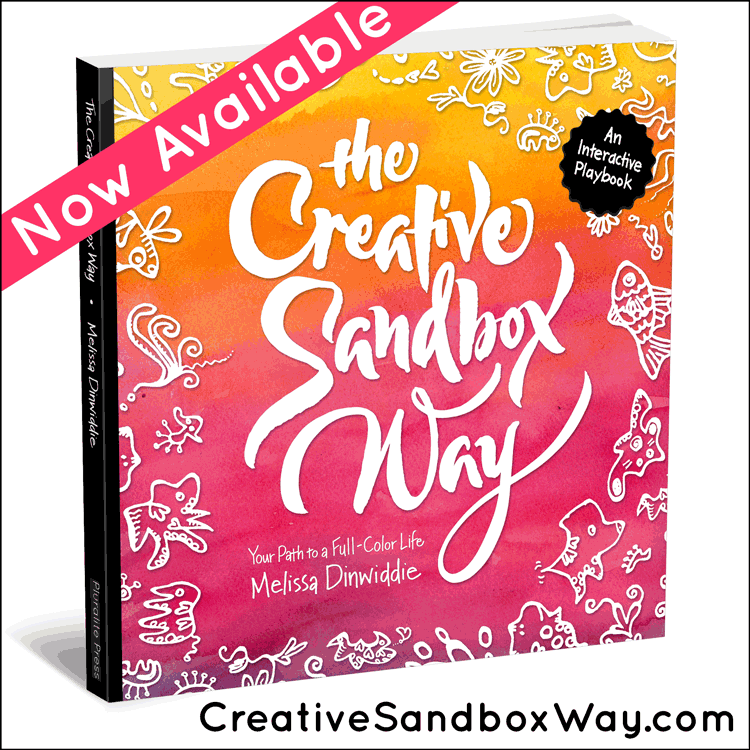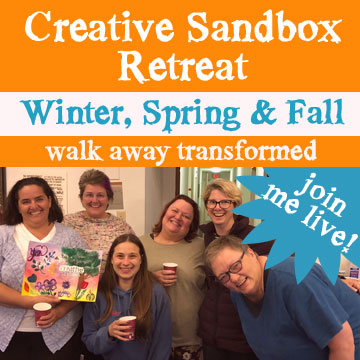
The other day I was leading a group call and something happened that I wanted to share, because I know it’s relevant to a lot of people. Lumpy gravy is involved, and microscopes, and corrals. It’s all in service of avoiding distractions so you can get your important work done and live the full-color life you long for.
First. some background.
One of the things we do in some of my programs is something I call Studio Work Days.
We all log in or dial in to a video conference room at a specified time, share what we intend to accomplish in the next chunk of time (usually anywhere from one to three hours) and then we all get down to work, (virtually) side by side. At the agreed-upon end time, we gather once again to report back on how much we accomplished.
This Studio Work Day format creates a wonderful sense of camaraderie, of creating in tandem, which makes getting down to work a whole lot more fun. Knowing that you’re working alongside other people tends to be amazingly motivating!
And because each Studio Work Day session has a built-in (and short) deadline (we’re all meeting at the end to report-back), plus accountability (we’re all reporting back to each other), when members make their goals specific and measurable we become like a magical productivity factory.
Plain and simple, we get stuff done.
At this particular report-back call, however, one of the members, Mary, was relating that she’d gotten distracted from the goal she’d committed to.
Productivity Power Tool: Mindfulness
It happens, right?
The great thing was that she noticed. Thats where it all starts, with awareness.
If we can be aware, if we can be mindful of what we’re doing when we’re doing it, it creates space for us to then make a conscious choice of what happens next.
When we’re unconscious, we just keep doing whatever we’re doing — clicking links, diving deeper into Facebook, eating tortilla chips out of the bag, whatever. We’re just going to keep rolling on auto-pilot.
But when we’re mindful, and aware of the present moment, what we’re doing and how we’re feeling, then we can make choices about what we want to do next.
So I asked Mary what had happened, what pulled her away. Well, she said, the phone rang, and then she remembered there was an email she wanted to reply to, and then when she opened her inbox there were all these other emails, and she got sucked into answering them, and then …
I asked if any of those things, the emails, the phone calls, were truly essential for her to deal with right then.
She hemmed and hawed, but ultimately, the answer was no. None of it was truly urgent, it just felt urgent in the moment. All of it could have waited for a few hours.
This was great to know!
Productivity Power Tool: Self-Compassion
Mary was really angry with herself for letting herself get sucked in, but I counseled her not to beat herself up, but to love herself up instead.
Why?
First, although Mary (like most of us) believed that the only way to get herself to stay in line is to carry a big metaphorical stick and beat herself with it liberally, in fact, the opposite is true.
Hard as it may be to believe, all the scientific research — not to mention my personal experience, and the experience of my clients and students — shows that responding to stumbles with self-forgiveness and self-compassion leads to much greater success at goal achievement than responding harshly.
(If you’re resistant to this idea, I have one question: How’s that big stick approach workin’ for ya?)
In fact, as I told Mary and the rest of members on the call, understanding that all of those distractions could have waited was cause for celebration, because now she was in a better position to avoid the same kind of stumbling blocks in the future!
The Golden Formula
This is a great example of how to implement my Golden Formula: Self-awareness + self-compassion = the key to everything good. (Click to tweet!)
Here’s how my Golden Formula operates in the real world:
First, notice that something happened that you’re not happy about. (This is the self-awareness piece.)
Then (this is the self-compassion piece),
- Forgive yourself for the “crime” of being human.
- Remind yourself that you are human, and therefore fallible, but still deserving of love and kindness.
- As you would for your dearest friend or a beloved child, gently and lovingly assess what you can can change going forward in order to help avoid the same trap in the future.
So far, Mary had made progress on the self-awareness piece — she had noticed what had happened, albeit after the fact. The next step was to use self-compassion to look at how to prevent similar traps from tripping her up in the future.
I dug a little deeper.
Under the Microscope
The first trap Mary fell into was answering the phone, so I wanted to defuse that land mine as much as we could.
“Are there other phone calls that you absolutely have to be able to pick up?” I asked. “Do you need to hear the phone ring?”
Well, there are certain emergency calls that she truly does need to be available for, but those calls only ever come in on the landline, and everybody else uses her cell phone. And her cell phone was where the call that pulled her off track came in.
“Great!” I said. “So next time you can turn off your cell phone — just put it in Airplane mode, and you won’t get sucked away by that particular distraction again!”
Easy-breezy, right?
Except that Mary was resistant, and her reason for resisting really surprised me.
She said, “But I don’t feel like I should have to turn off the phone. I should be able to just avoid answering it.”
The Lumpy Gravy Problem
Ah. This brought to mind a story from when I was in high school or college.
[Cue the harp music, signaling that we’re going back in time.]
It was Thanksgiving, and my mom and I were in the kitchen. Dad had brought a pan of drippings in from the grill, where the turkey was roasting, and Mom was about to make gravy.
As she did every year, my mom was lamenting that she’s simply incapable of making gravy that doesn’t have lumps in it. This year, however, I was prepared!
I’d discovered in a cookbook an easy trick for avoiding lumps: simply mix a little bit of the liquid into the flour first, before adding to the pot with the rest of the drippings. That small amount of liquid with the flour makes a smooth paste — no need to lamely chase after lumps in the big pot with your spoon.
I was so excited! I had the solution my mom had been looking for since I could remember, and it was so easy!
But Mom wanted nothing of it.
“Oh, no,” she protested, “Real cooks don’t need to do that! A professional chef wouldn’t need a trick like that.”
I was flabbergasted.
“No, Mom,” I said. “This is what real cooks do. Professional chefs are professional chefs not because they’re born with some magic skill, but because they’ve learned the techniques that produce the best results.”
(Actually, I’m sure what I really said was much less articulate that that. But this is what I like to imagine that I said. 😉 )
My mom wasn’t having it, though. She insisted on making gravy the way she’d always made it.
And guess what: it was lumpy.
[Cue the harp music, signaling that we’re now back in present time.]
Just like my mom, who refused to use a proven technique because she felt she should be able to make smooth gravy without it, Mary didn’t want to use a proven productivity technique because she felt she should be able to stay on track without it.
Hogwash!
A cook who wants to make smooth gravy is foolish if she doesn’t use the simple, proven techniques that the pros use to avoid lumps.
A creator who wants to stay on track with her projects is foolish if she doesn’t use the simple, proven techniques that the truly productive use to avoid getting sucked away by distractions.
A Dangerous Era: Dopamine Hyperdrive
Here’s the thing. When it comes to distractions, we live in the most dangerous era in history.
Your inbox, your social media accounts, your web browser are reaching their beckoning fingers at you — poking you to provoke a response — thousands of times a day. If you’ve got a smart phone or other mobile device, you’re carrying those dangerous distractions with you everywhere you go!
Every notification that pings in your ear or pops up on your screen, every ring of a phone, triggers a rush of dopamine through your brain, making you feel that you must stop everything right now in order to see what might be waiting.
It’s not your fault. It’s how we’re wired.
Dopamine is the brain’s brilliant mechanism for getting you to take action, a product of evolution that ensured the human race didn’t die out because nobody could be bothered to pick a berry or chase after a potential mate.
All very good in a hunter-gatherer society living on the veldt. Not always so helpful in an era of hyper-connectedness.
It would be self-sabotaging (even downright stupid) for a professional chef not to use the techniques that give the best results, and it’s the same for you and me.
This is why, if you want to be productive and prolific, your job as a creator is to put yourself under the microscope. (Click to tweet!)
From the Microscope to the Corral
Suss out where you get pulled off track. Then design scaffolds, fences, funnels, and safety nets to corral you toward your desired goal, keep you on track, and help you get right back on if you do derail (as you will at some point, because you’re human, remember?)
Some examples:
- Turn off your phone, or put it in Airplane Mode.
- Close the door, and/or put a sign on it that you are not to be disturbed.
- If you’re on a computer, close out ALL tabs except the one you’re doing actual work in.
- Install an app that will prevent you from accessing social media or other “rabbit hole” sites (here’s a good list).
- For writers, use a tool like Omwriter or the Distraction-Free setting of WordPress, Microsoft Word, or Scrivener.
- Create a dedicated work space, just for your creative thing, where you can leave your projects up all the time (no hurdles to leap before getting started!)
- Get into the habit of clearing away detritus and completed projects, and set up your tools and materials for the next session at the end of your current session, so your work table is always ready for immediate use.
I know someone whose family put a typewriter on a little table in the hallway that led to and from the kitchen. Every time they walked down the hall, at least three times a day for meals, each family member would add a line to whatever story or poem was in the typewriter. Voilá — instant daily writing practice! And for the whole family!
I had one client whose big goal was a daily drawing practice, but he kept getting sidetracked. We determined that the best time for him to draw was in the morning, right after breakfast, but his computer was like a super-strong magnet, and once he sat down at his monitor, he never got to his creative thing.
He didn’t like to shut his computer down at night, so we figured out a low-tech workaround: he covered his computer with a towel before he went to bed, to remind him to do some painting before heading to his email. It worked like a charm.
Of course, he could pull the towel off his computer in a split second, so it wasn’t a true barrier, but it created enough of a hurdle that it successfully interrupted his automatic “jump on the computer right after breakfast” behavior.
And really, that’s all it takes — a small interruption to switch us off of autopilot is often enough.
Lots of Corrals = Supercharged Productivity = Happiness = Full-Color Life
Once you install one corral, you can stay on the lookout for others that can help, too. Keep putting yourself under a microscope and practicing my Golden Formula. Keep noticing your stumbling blocks, then figure out how to corral yourself past each one toward your goal.
In chef’s school, cooks learn technique after technique, little by little, over the course of their program. Making smooth gravy is one of a zillion individual techniques, that, taken together, make for a great professional chef.
You can do the same thing in the school of life.
Little by little, you’ll accumulate technique after technique that, taken together, make for supercharged productivity, happiness, self-fulfillment, and a full-color life.
So don’t get down on yourself if you, like Mary, have a tendency to let distractions pull you off track. Human beings have a genetic tendency to get distracted by anything that triggers a dopamine hit, just as flour has a molecular tendency to form clumps. Thankfully, there are techniques for dealing with both situations!
The difference between the pros and the struggling masses is that the pros implement the techniques. Do that and you’re golden.
Now go forth and create.

PS — Pssst! Know someone who might benefit from seeing this today? Pass it on!





Hi Melissa, I’ve only recently discovered your site through Abundant Artist and I’m so enjoying your posts. Congratulations on your exhibition.
Aw, thanks, Henrietta! So glad you found me. 🙂
I’ve been reading your posts for a while and I always end up being cheerful and energetic afterwards!
Thanks for your wonderful insights Melissa!
THAT is the best gift I could get, Maria — knowing that my posts help you become more cheerful and energetic! Yay! Thanks for letting me know. 🙂 xo
Good morning Melissa…and THANK YOU 🙂
Aw, you’re welcome. And thanks. 🙂
another great reminder, melissa – thanks!
Yay! So glad it spoke to you, mj. 🙂
Love the Lumpy Gravy story. Best part is that it’s true, AND I have a similar story from my Dad only in the garage using tools on a woodworking project. Could never understand why he would stubbornly cling to his technique, when there was a smarter, easier way to get a better result. The Lumpy Gravy sure brought back a bunch of memories! Thank you for your inspiration!
Haha! That is too funny, JR. People are funny. 🙂
Oh and Congrats on your show! “Big things have small beginnings.”
Aw, thanks! Here’s to THAT! 🙂